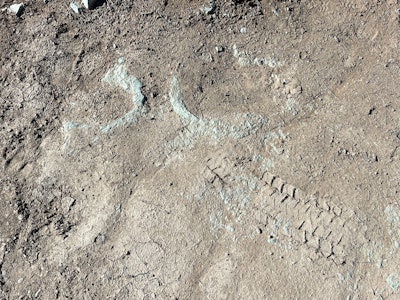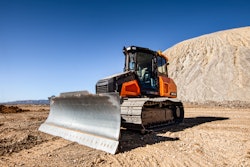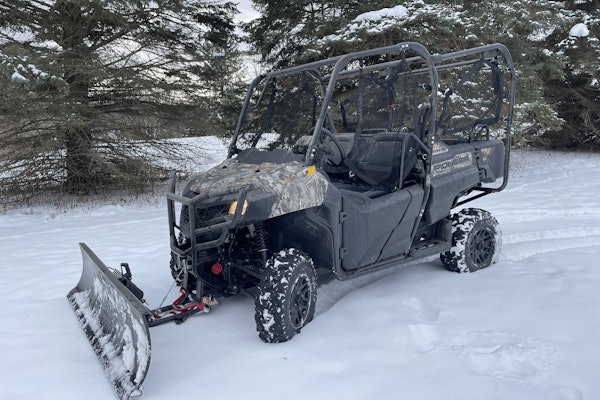
A federally funded construction project to dismantle and rebuild a boardwalk over a prehistoric site damaged a section of 112-million-year-old dinosaur footprints at Mill Canyon Dinosaur Tracksite in Utah.
Preliminary assessment of the site by a U.S. Department of Interior Bureau of Land Management Utah regional paleontologist found that some damage had occurred to the dinosaur footprints.
“This is unacceptable. The BLM is committed to ensuring that further damage will not occur,” the agency statement reads.
Work on the new boardwalk was halted on January 31 in response to a cease-and-desist letter sent by Patrick Donnelly, Great Basin director at the Center of Biological Diversity. It was one of several criticisms and complaints the agency received within days of the alleged damage occurring.
 View from the boardwalk, built above the tracks to protect them from foot traffic and erosion. The construct project is intended to upgrade the boardwalk.Bureau of Land Management
View from the boardwalk, built above the tracks to protect them from foot traffic and erosion. The construct project is intended to upgrade the boardwalk.Bureau of Land Management
According to Donnelly, a backhoe left on the site had driven directly over the fossil dinosaur tracks, permanently destroying as much as 30% of the paleontological resources on the site.
The cease-and-desist letter from Donnelly noted that destruction of the dinosaur footprints violated the Paleontological Resources Preservation Act of 2009. In addition, questions were raised as to whether the Bureau of Land Management Utah may also be in violation of the National Environmental Policy Act and the Federal Lands Policy and Management Act for failing to adhere to project approval documents.
According to Donnelly, the 2009 Paleontological Resources Preservation Act states that the BLM is to “manage and protect paleontological resources on federal land using scientific principles and expertise.” The law further states that “a person may not excavate, remove, damage or otherwise alter or deface ... any paleontological resources located on federal land.”
Further, Donnelly alleged that the land management agency failed to adhere to its own environmental assessment of the property.
According to the BLM statement, work will remain halted at the site until a final paleontological site assessment report is complete, which is expected in three weeks.
Furthermore, to complete the project, the BLM says it will review recommended approaches from the paleontologist and conduct further analysis under the National Environmental Policy Act, which will include a public comment period. In addition, before construction resumes, the site will be surveyed, flagged, and any additional work will be monitored by an onsite qualified paleontologist.
As presented, all the promised actions mirror the allegations brought against the agency by Donnelly in the cease-and-desist letter. He notes in the letter that the original environmental assessment simply stated that “reconstruction of the walkway has the potential to disturb existing paleontological resources. Conditions of approval (marking and flagging of tracks close to the construction site and requirement of onsite inspections during construction) have been imposed to safeguard the paleontological resources.”
 A pile of the ripped apart boardwalk lies within feet of a portion of the tracksite.Jeremy Roberts
A pile of the ripped apart boardwalk lies within feet of a portion of the tracksite.Jeremy Roberts
Also, the original project assessment did not include a review by a paleontologist. Rather a geologist determined if use of heavy equipment around the site should be allowed. No fossil expert oversaw the construction at the time the damage occurred, unlike when the boardwalk was originally installed in 2013.
Reports suggest that like many government agencies, the Bureau of Land Management suffers from staff shortages. Several commenters on social media and in other news outlets have noted that there has been an open paleontological position in the BLM’s Moab, Utah office since 2018.
“The dinosaur tracks on this site tell a story from millions of years ago. The BLM has a responsibility to ensure this story is still told thousands of years from now, and the agency is committed to this future,” the latest statement read.
Despite a commitment to the future of the site, the latest statements by the BLM are a near reversal of its original position on the issue.
Initial statements by the BLM after halting work at the site had suggested that there was no evidence of damage in the interpreted area, although a team was being dispatched to conduct an assessment with a paleontologist and to work with “communities of interest to see what the long-term vision should be for the trackways.”
Also, the agency had acknowledged that heavy equipment was on location during the construction of the boardwalk but indicated that it “is absolutely not used in the protected area.”
Preliminary reports of the damage at the site, which is described as one of the most significant early Cretaceous tracksites in the world, were reported via social media a couple of weeks ago.
Heavy machinery, including a backhoe still on site, had allegedly driven over sections of the dinosaur prints, leaving tread marks across the prehistoric landmarks. The equipment was present to complete reconstruction of a wooden boardwalk that takes visitors safely around the Mill Canyon Dinosaur Tracksite while also assisting in preserving the fossilized footprints.
The original boardwalk was installed in 2015 around the time the site was opened to the public, with oversight by a paleontologist. In October 2021, the Bureau of Land Management Utah had approved a new project to update the wooden boardwalk, suggesting that the boardwalk was warping and presented a serious tripping hazard, necessitating an update to corrugated metal and concrete.
Despite the BLM’s original denial of damage, Utah State Paleontologist James Kirkland appeared to have confirmed the existence of at least some damage to the site, prior to the formal statement released Wednesday.
According to The Deseret News, Kirkland reportedly found damage when he visited within days of the allegations coming to light.
“There is damage and there is no reason there should be any damage,” Kirkland said. “It is not completely destroyed as some people were suggesting, but I was pretty scared.”
He suggested that the damage was needless as the project should have gone through a public comment process, which likely would have alerted more stakeholders to the concept. According to Kirkland, by the time people heard about the project, it was already underway.
“There’s damage and it is unnecessary. This should have been done with a real sense of excellence. ... Mill Canyon was a major discovery and a real jewel in Utah’s crown,” he said.
Kirkland said the funds would have been better suited for construction of a shelter to protect the site from the elements, and he believes any paleontologist would have gone down to Mill Canyon to oversee the project if asked.














